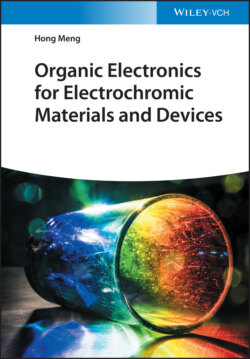Читать книгу Organic Electronics for Electrochromic Materials and Devices - Hong Meng - Страница 25
2.3.1.1 PEO‐/PEG‐Based Electrolytes
ОглавлениеPEO (with a molecular mass above 20 000 g/mol) or PEG (with a molecular mass below 20 000 g/mol) simply refers to an oligomer or polymer of ethylene oxide. PEO‐based electrolyte is the earliest and most widely studied matrix for the formation of PE. Since Armand proposed a PE based on polyethylene oxide (PEO) for lithium batteries in 1978, research in this field has been extensively carried out [33]. Polyethylene oxide (PEO) has a polar ether group and significant segment mobility. As a wide range of salt polymers, especially high lithium ion stable polymers, it has excellent compatibility [34]. But because of high crystallinity, low melting point, limited operating temperature range, low hydroxyl ion migration number, poor interface characteristics, and other shortcomings, it fails to achieve the desired effect. In PEO‐based electrolytes, the most common method of increasing ion dissociation is the use of low lattice energy salts and to add fillers, which may prevent formation of polymer crystals, resulting in fast ion transportation via an interaction between the fillers and electrolyte [35]. PEO–H3PO4 and (PEO)8–LiClO4 were studied for electrochromism in devices [36]. However, the low Li+ conductivity inhibits its applicability. Later, PEO–LiSO3CF3 and PEO–LiN (SO2CF3)2 were reported to reach higher ion conductivities [37, 38]. PEO used as electrolyte in the gel form with an ionic conductivity of 2 mS/cm was reported in WO3 film ECD, which exhibited superior EC performance and memory characteristics [39]. In addition, PEO‐based GPE plasticized with ethylene carbonate/propylene carbonate or N‐butyl‐3methylpyridinium trifluoromethane sulfonylimide (PTFSI) has been studied by Desai et al. for the ECD [40]. Ionic conductivity can be significantly enhanced and the phase separation of the PEO and plasticizer was inhibited. Yang et al. studied the performance of the EC device prepared using poly(2,5‐dimethoxyaniline) (PDMA) and tungsten oxide (WO3) as electrode materials and PEO‐LiClO4 as GPE plasticized with polycarbonate [41]. Similarly various other hybrid electrolytes based upon PEO were successfully applied in EC applications [42].
